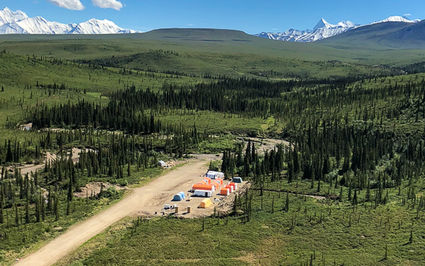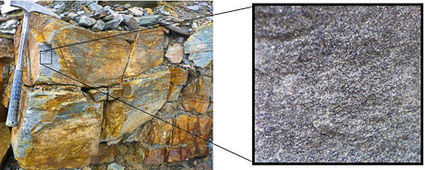ME2018: White Rock Minerals Ltd.
Last updated 11/1/2018 at 9:55am

White Rock Minerals Ltd.
This camp served as headquarters for expanding the known high-grade zinc deposits on White Rock Minerals' Red Mountain project and reconnaissance exploration across the wider 35,300-acre property in Alaska.
Australia-based White Rock Minerals Ltd. set its sights on Alaska's vast and underexplored mineral potential when it acquired Red Mountain, a zinc-rich volcanogenic massive sulfide project about 60 miles south of Fairbanks, in 2016.
While the two main deposits at Red Mountain – Dry Creek and West Tundra Flats, or WTF – had more than 120 historical holes drilled into them when White Rock acquired the property, a deposit had not been defined to modern reporting standards until last year, when the Aussie explorer had a calculation completed that met the standards of the Australian Joint Ore Reserves Committee.
This maiden JORC-compliant calculation found that Dry Creek and WTF host 16.7 million metric tons of inferred resource averaging 4.1 percent (1.49 billion pounds) zinc; 1.7 percent (630 million lb) lead; 0.2 percent (57.3 million lb) copper; 99 grams per metric ton (53.5 million ounces) silver; and 0.7 g/t (352,000 oz) gold.
White Rock got off to an early start to the Alaska exploration season by launching a drill campaign in May focused on upgrading and expanding the two known deposits and investigating Red Mountain's district potential.
The first two holes reported from this program encountered exceptional zinc, silver and gold grades at Dry Creek.
Hole DC18-77 cut 4.26 meters averaging 4.8 percent zinc, 2.3 percent lead, 1,435 g/t (46.1 oz/t) per silver, 2.2 g/t gold and 0.5 percent copper – equivalent of 43.2 percent zinc when accounting for the value of all the metals. This was part of a 9.39-meter intercept that averaged 2.6 percent zinc, 1.3 percent lead, 686 g/t silver, 1.1 g/t gold and 0.3 percent copper, or 21.1 percent zinc-equivalent.
DC18-79, drilled about 900 meters east of hole 77, cut 4.72 meters averaging 19.5 percent zinc, 7.8 percent lead, 466 g/t silver, 6.9 g/t gold and 1.5 percent copper, or 49.7 percent zinc-equivalent. This was part of a 16-meter intercept that averaged 6.4 percent zinc, 2.6 percent lead, 152 g/t silver, 2.2 g/t gold and 0.5 percent copper, or 16.1 percent zinc-equivalent.
Being outside of the current resource area at Dry Creek makes the high-grades even more exceptional and highlights the potential of enlarging both the grade and size of the deposit.
WT18-28, the first 2018 hole reported from WTF, cut 3.45 meters averaging 15.1 percent zinc, 6.7 percent lead, 518 g/t silver, 2.1 g/t gold and 0.2 percent copper, or 35.2 percent zinc-equivalent.
"These first drill assay results for the Dry Creek and West Tundra deposits validate our belief that these two deposits form part of a genuine high-grade zinc-rich polymetallic VMS mineralization system," said White Rock CEO Matthew Gill.
As drills expanded Dry Creek and WTF, crews carried out geophysical surveys, mapping and sampling across the VMS deposits to determine the best exploration tools to use to prioritize the 30 earlier staged prospects across the roughly 35,000-acre property.
This orientation work found that highly conductive anomalies were easily and economically identifiable with controlled-source audio-frequency magnetotellurics, or CSAMT, geophysics.
"The stark conductivity anomaly results seen and their coincidence with known massive sulfide mineralization gives White Rock a powerful exploration tool with which to identify new targets for drill testing, hopefully leading to resource expansion and the discovery of new deposits," said Gill.
Hunter was the first major discovery of the 2018 reconnaissance exploration program at Red Mountain.
While mapping and sampling an area about 5,200 meters southeast of Dry Creek, crews identified a two-foot massive sulfide outcrop rich in sphalerite (zinc mineralization) and galena (lead mineralization) at Hunter.
Further prospecting at Hunter mapped massive sulfide mineralization for about 500 meters along strike that is associated with carbonaceous phyllite that can be traced more than 1,000 meters.
The first two holes drilled at Hunter encountered the massive sulfide mineralization up to 80 meters down-dip from the outcrop.
Hole HR18-01 cut 1.4 meters of massive sulfide averaging 17.4 percent zinc, 3.9 percent lead, 90 g/t silver and 1.6 percent copper. This equates to 25.8 percent zinc-equivalent when you consider the value of all the metals encountered.
Hole HR18-02, which was drilled from the same pad at a shallower angle, cut 1.8 meters averaging 13.8 percent zinc, 3.1 percent lead, 56 g/t silver and 0.9 percent copper, or 19.5 percent zinc-equivalent.

White Rock Minerals Ltd.
This two-foot massive sulfide outcrop rich in sphalerite (zinc mineralization) and galena (lead mineralization) was discovered at the Hunter prospect during White Rock's reconnaissance exploration at Red Mountain.
"There aren't many places in this world where you find outcropping zinc-rich massive sulfide (with lead, copper, silver and gold) and then promptly drill test that and get a positive response," said Gill.
-SHANE LASLEY
White Rock Minerals Ltd. - ASX: WRM
Chairman: Brian Phillips
Chief Executive Officer: Matthew Gill
Exploration Manager: Rohan Worland
24 Skipton Street
Ballarat, Victoria, Australia 3350
Tel: +61 3 5331 4644












Reader Comments(0)